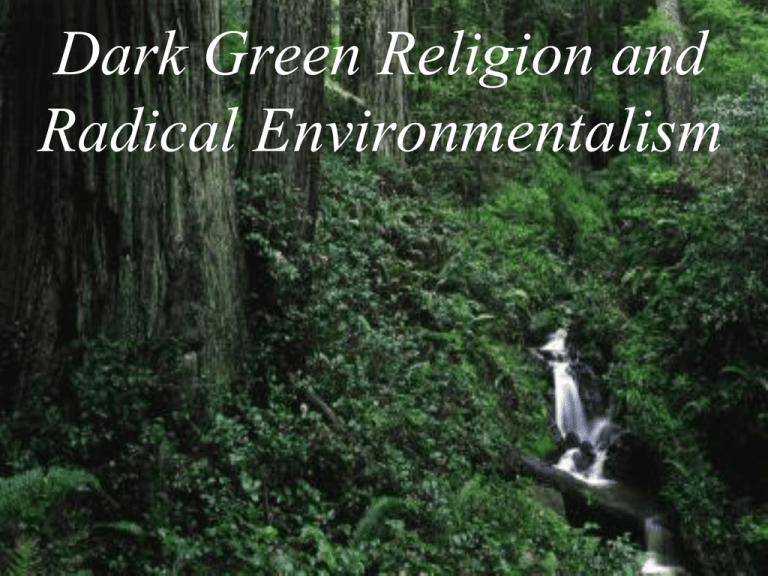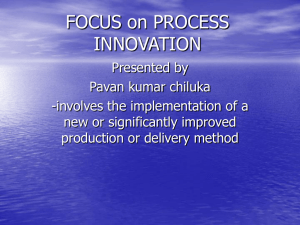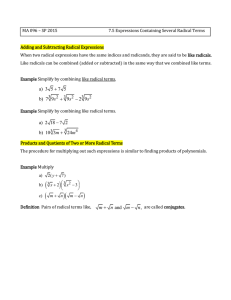- Bron Taylor
advertisement

Dark Green Religion and Radical Environmentalism Some of the following slides both reference specific individuals and aspects of radical environmentalism that were discussed in Dark Green Religion. Others provide images that illustrate, somewhat impressionistically, the political, ethical, and spiritual bricolage that characterizes the movement . William C. Rogers, aka Avalon Vail Colorado Ski Resort Building, set on fire in 1998 by Avalon & others in the Earth Liberation Front Bioregional Deep Ecology and Radical Environmentalism • Spiritual Biocentrism ~ The earth and its life processes are sacred - but Western religion & philosophy foster anthropocentrism that leads to an. . . • Extinction Crisis fueled by the greed of corporations and . . . • Corrupt Governments which refuse or otherwise fail to arrest these extinctions Binary Associations in Radical Environmentalism and Deep Ecology Good Bad Foraging (small-scale organic horticultural) societies Pastoral and Agricultural Societies Animistic, Pantheistic, GoddessMatriarchal, or Eastern Religions Biocentrism/Ecocentrism (promotes conservation) Intuition Monotheistic, Sky-God, Patriarchal, Western Religions Anthropocentrism (promotes destruction) Reason (especially instrumental) More Binary Associations Good Bad Holistic Worldviews Mechanistic & Dualistic Worldviews Decentralism Centralization Primitive Technology Modern Technology Regional Self-Sufficiency Globalization and International Trade Anarchism/Participatory Democracy Statism, Corruption, Authoritarianism Radicalism Pragmatism Grief and anger over the destruction of nature fuels movement passions. Social criticism, history, ecology, and myth fuse in a radical worldview which shapes political priorities, and justifies lawbreaking Ecological Analysis fuels the ubiquitous Apocalypticism, found in movement literature, poetry, and music • e.g., “Time Bomb,” “Ghost of a Chance,” “Disorder,” and “End of the World.” (see sound section for downloadable music) We who can still hear the jaguar scream We dream of a day when all things wild will again be free… It is a dream we will fight for until the day we die Ecological Analysis fuels the ubiquitous Apocalypticism, found in movement literature, poetry, and music • e.g., “Time Bomb,” “Ghost of a Chance,” “Disorder,” and “End of the World.” The Myth of the Fall from a Foraging Paradise • Agricultures destroy or force the conversion of indigenous peoples living in harmony with nature • Agricultures replace foraging societies and their place-based gods and nature spirits and ethics of kinship toward all life forms, with sky-gods. To re-harmonize humans in nature we must re-sacralize our perceptions of the earth. Resacralize earth by promoting animistic and pantheistic perception through . . . • The Arts – poetry, prose, music, dance, visual art can evoke proper spiritual perception • Ritualizing – recovering and re-inventing green religion • Ethical Action – defending the earthen spiritualities of surviving indigenous nations Roadshows as Wilderness Revival Meetings The Council of All Beings . . . ritualizing toward a kinship ethic with non-human nature Advanced Ritual Workshops . . . deepening proper spiritual perception Direct action . . . binding people with each other and the natural world Radical Environmentalism and Bioregional Deep Ecology ~ A “bricolage” of spirituality, ecology, and radical political ideology Songs like “I am an Animal” (Dana Lyons) express the kinship ethic and antianthropocentrism of the movement. (see favorites/sound) Radical Greens v. Bioregionalists ~ Differing Strategic Priorities Radical Environmentalists: Engage the Destroyers – Resist!!! Bioregionalists: Promote sustainable lifeways Dave Foreman – Prophet of Radical Gary Snyder – Environmentalism Architect of Monkeywrenching or Bioregional Social “ecotage” is “a form Philosophy of worship toward the earth. It’s really a “The closer you get to very spiritual thing to real matter, rock air go out and do . . . firewood, boy, the You are a religious more spiritual the warrior for the world is” Earth.” Let our Action Be our Prayer . . . ‘cause if you haven’t done everything imaginable, you haven’t done shit! Fortress Wall, Warner Creek Blockade, Oregon (USA): The year long blockade was eventually successful in blocking a large timber sale 1993 Spiritual Warfare . . . Voodoo doll to scare loggers, who are often conservative Christians. PAGAN PENTAGRAM ~ some radical environmentalists are self-consciously pagan. Cove Mallard, Idaho . . . Earth First! Army Corp of Engineers . . . Barricades made from trees cut for logging roads, rearranged to blockade the loggers from access to the large timber sales in Idaho (USA) 8-10 9-10 Album Cover . . . note the burning bulldozer in the background 2-6 Live Wild or Die urges a feral revolution of desire, anarchist rebellion, and inflammatory tactics. This is the cover of its premier issue (1989) 3-6 Drawing rubric from European paganism and the model from the most militant EF! Activists, “Elves” in the UK form the Earth Liberation Front (1992) 4-6 The swiftness of deer The vision of eagle The strength of bear The sureness of cougar The stealth of snake The wildness of wolf Guide these steps of mine My hand as it releases These flames of life’s hope Toward that which would destroy us all. “Destroy what destroys you!” Bioregionalism Consecrating Home, and Venerating Earth, through sustainable living Bioregionalism’s focus. . . • Premise: those who live in a place can better learn its and nature spirits and sustainable lifeways than people far away • Goal: Redraw political boundaries to cohere with those of different ecosystem types • Hope: overturning nation-states in favor of decentralized, regional, community selfrule. Bioregional Strategy: Promote sustainable lifeways • Promote regional identity and activism through: – bioregional congresses and local groups – Permaculture and Organic Agriculture – pagan ritualizing – Bioregionally-oriented wildlands advocacy Relative optimism or Apocalypticism shapes the strategic choices: • Could catastrophe be averted through human action? • Can governments play a positive role? • Does hope lie only after the collapse of industrial civilization and the destruction of modern technology? Bioregionalists are slightly more hopeful than radical environmentalists – They generally expect that industrial society will collapse, but are less sure this will occur dramatically and with great suffering – They retain some hope we can learn our way toward sustainability, rather than have it forced upon us by ecological collapse. Yet, Apocalypticism reigns among virtually all radical environmental activists and most bioregionalists. Is there an international ‘Radical Environmentalism’ and ‘deep ecology’ movement? Colin Campbell’s theory of the ‘cultic milieu’ is illuminating in this regard. Campbell: The West as ‘breeding ground’ for a ‘Cultic Milieu’ . . . • . . . the “the cultural underground” of Western Civilization including “all deviant belief-systems and their associated practices including heretical religion and deviant medicine and science.” • Cultic groups are generally tolerant and receptive to each other’s beliefs >> syncretism . . . • they share a mystical tradition emphasizing that “unity with the divine can be attained by a diversity of paths” Expanding on Campbell’s theory, Radical Environmentalism and Deep Ecology movements can be viewed as a bricolage of spiritual epistemologies and traditions, as well as of countercultural political ideologies and movements Re. Spiritual epistemologies. . . ‘earthen spirituality borrows widely: Mountain epiphanies • Muir and all of Deep Ecology’s developers and earliest proponents, were mountain climbers. • Naess, estranged from people, found solace and connection in nature, and felt “love” from the mountains with which he identified. • Deep ecology intellectuals are often drawn to Spinoza and pantheism. Arne Naess, and other deep ecologists and radical greens urge us to re-discover the animistic perceptions of our childhoods, claiming they are still present among tribal peoples. Naess states the epistemological premise so common in the movement: “To do this we must spend time in mountains, or where ‘free nature,’ can stimulate a sense of oneness, wholeness, and identification with nature.” 1-2 Such episteme, and the general radical environmental myth, fuel the impulse to borrow from Native American cultures and spiritual practices, as well as eastern religions, which are viewed as superior to western societies. Taoism and esp. Buddhism influence the West’s spiritual countercultures, perhaps nowhere as significantly as in bioregionalism and radical environmentalism. ~ e.g., Gary Snyder, Joanna Macy, John Seed, Dolores LaChappelle, Michael Soule, Reed Noss, to name a few. ‘Earthen Spirituality’ is contested in multiple ways, and criticisms of such appropriation have altered practices in the radical environmental movements. • Sacred objects sometimes removed • Sweat Lodges become “sacred saunas” • Activists turning to own heritages, as much as possible. • Yet shared ritual is common, as with prayer and purification during litigation. Other ways ‘Earthen Spirituality’ is contested: • Battles between Indian and Non-Indian activists and Christians opposing their ‘paganism.’ • Activists, sometimes clumsily, try to express solidarity with Native Americans (at least ones they believe are still connected to the land and its spirits). These slides are from the campaign to prevent telescopes from being constructed on Mt. Graham in Southeastern Arizona (1993). Environmentalists and Native Americans in their own ways believed the project would desecrate a sacred place. The Vatican Observatory was involved in the project which intensified the religious dimensions of the conflict Despite some criticism, Native American images and practices remain important in dark green spirituality. North America as Turtle Island Turtle Island & totem salmon in a mandala inspired by religions of the far east Desert epiphanies (Edward Abbey) The desert's austerity “distinguishes it, in spiritual appeal, from other forms of landscape,” and is more effective than mountains at overturning human arrogance. Abbey called himself an “earth-ist” and was a pantheist who “saw the spirit in all things” (Loeffler) . . . And resonated with Daoism, considering it ancient nature-based spirituality, calling “the Tao te’ Ching is the best goddamned book ever written.” Hallucinogens (or ‘Entheogens’) • “Decisive” or important impetus for some involved in dark green religion. • Peyote “sets one up spiritually to understand the sacred quality of this planet . . . It puts one in direct contact with another wave-length with the universe and one immediately intuits that the entire planet is the living organism in which we are members” (Jack Loefler, “Ed Abbey’s best friend”) • Only extended, solo camping provided equally powerful spiritual perceptiveness, according to many radical environmentalists. An “Ecotopian Holy Trinity” song, sung by the late Judi Bari and her comrads, lauded the spiritual teachings of marijuana, magic mushrooms, and “big old trees.” (Neo) Paganism . . . • Critically and increasingly influential, ~ practitioners spread its ritual resources widely in green circles. ~ Drawing on putatively European sources, it is seen as less problematic than forms drawing on indigenous societies. Deep Ecology Ritual goes international ~ this graphic is from a tabloid announcing a 1994 “Workshop for All Beings” in Poland. Time for an Entmoot . . . From Entmoot, the title of Washington EF!’s Newsletter, 1994 Here is another example of the ecelectic bricolage of dark green religion, and also, of the influence of the arts in inspiring it. … Wicca & Spiritual Ecofeminism Wicca is often in co-production with neopaganism, and incorporated into dark green spirituality ~ E.g., the Spiral Dance ritual spreads the metaphysics of interdependence. ~ Songs and art challenge patriarchy within and outside of green subcultures. Political Tributaries • From the ‘old and new left’, and antinuclear and anti-war movements . . . • To themes of “freedom” prevalent in the Western world • To individualist, libertarian forms common in many Western states. . . Political Tributaries (cont.) • increasingly, anarchism, which . . . • best fits the myth that a centralizing, totalitarian agriculture is destroying nature and everything spiritual. • Legitimizes priority on local politics • De-legitimizes centralized governments reinforcing Direct Action rationale Radical Affinities • Almost any radical perceived to be green and an opponent of a globalizing industrial civilization is honored. – Mumia abu Jamal, and Move, are looked to as an outbreaking of nature religion among Americans of African heritage. – AIM activists – Traditional Indians resisting development or displacement (e.g., the Hopi traditionalists) – Wangari Mathai and the Kenyan Greenbelt movement, and . . . The antiglobalization movement has many affinities with dark green religion and many of its supporters are radical greens. This photograph is from the protests against the World Trade Organization in 1999, which catapulted the movement into public consciousness. Hoping for the Collapse of Industrial Civilization as the only path to egalitarian, ecologically sustainable, societies (sometimes aided by anarchist revolution and even terrorism) … but some want to accelerate the process 2-6 If you can BAKE A CAKE . . . . . . you can MAKE A BOMB 3-6 One anarchist version of radical environmentalism. 4-6 Glen Canyon Dam, 4963 AD, after the collapse of industrial civilization, wildness is returning . . . … hopeful apocalypticism 1-6 Quietly passed around during the 1997 National Earth First! Rendezvous in Northern Wisconsin 5-6 The preceding slide is from a flyer passed out at a radical environmental gathering in the mid 1990s. The opposite side proclaimed: Return to Wild Nature and had these words: "Joan of Arc and the 19th century abolitionist John Brown employed violence and gave their lives in struggle. These visionaries were considered demented by their contemporaries, but are now revered. It may be that the Unabomber will be looked upon similarly, as a kind of warrior-prophet who, as Arleen Davila wrote, `tried to save us.' To unlearn our illusions is to begin to save ourselves . . . Return to Wild Nature - Destroy the Worldwide Industrial System - FREE TED KACZYNSKI." 6-6 What are we to make of all of this? . • What are the impacts of such countercultural spirituality and politics? • There have been many specific successes we could point to that have been won by these movements. • But their greatest influence may be just beginning, for . . . As argued in Dark Green Religion, Nature spirituality is not just for radicals anymore. It is altering the political and ecological landscape around the world .and entering the culture’s main streams. Increasingly found in survey research are • intrinsic value of nonhuman nature • ‘organicism/animism’ • ‘natural rights’ • to a lesser extent ‘pantheism’ Organizations are proliferating that are grounded in and promoting of such spirituality • Native Plant Societies (wild ones) • Butterfly gardeners • Biodiversity defense and restoration groups • Seed Saving , community supported agriculture, sacred agriculture movements (to name just a few) Even the U.S. Forest Service’s Leaders . . . increasingly articulate biocentric values and discuss positively the important “spiritual” value that nature has for Americans when defending new, forest protection policies For example, introducing a book on ecosystem management by his employees, USFS Chief Jack Ward wrote . . . “Nature-based spiritual beliefs are generic to all [forest] users, whether holders or nonholders of sectarian religious beliefs . . . diverse types of nature-based spirit-renewing benefits . . . are common across all types of users, whether a timber cutter, a hunter, a member of an environmental organization, a hiker, or a Native American. Dark Green Religion does have a radical branch and increasing impacts around the world. The question remains, what will the extent and timing of its future influences? Ecological Analysis fuels the ubiquitous Apocalypticism, found in movement literature, poetry, and music • e.g., “Time Bomb,” “Ghost of a Chance,” “Disorder,” and “End of the World.” Time bomb (Dana Lyons) sorder (Casey Neil)






